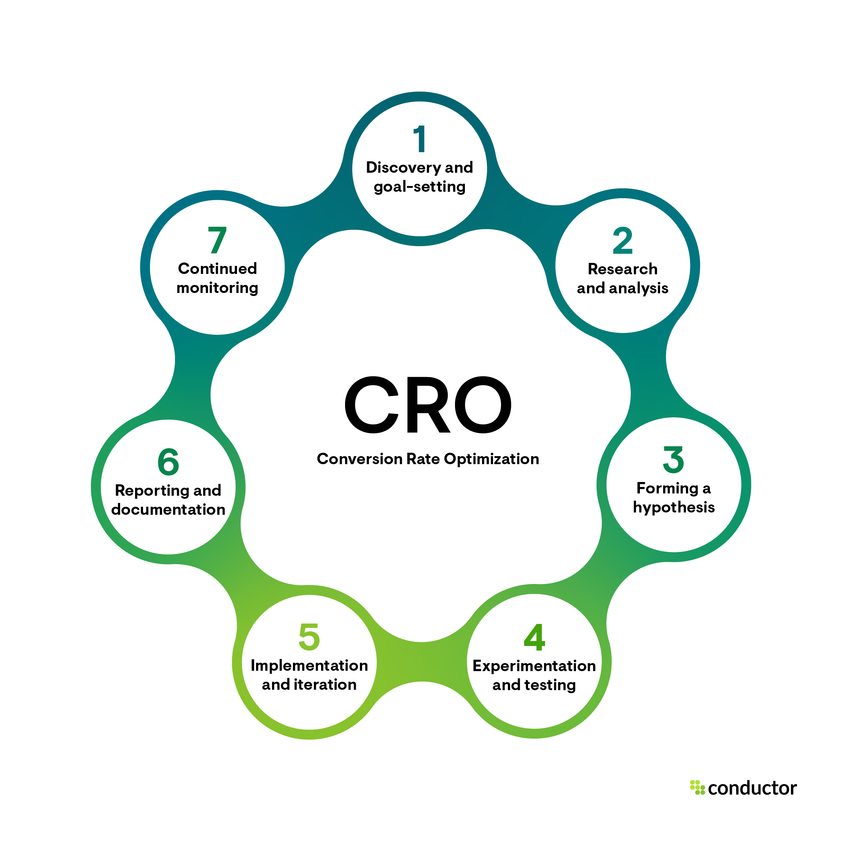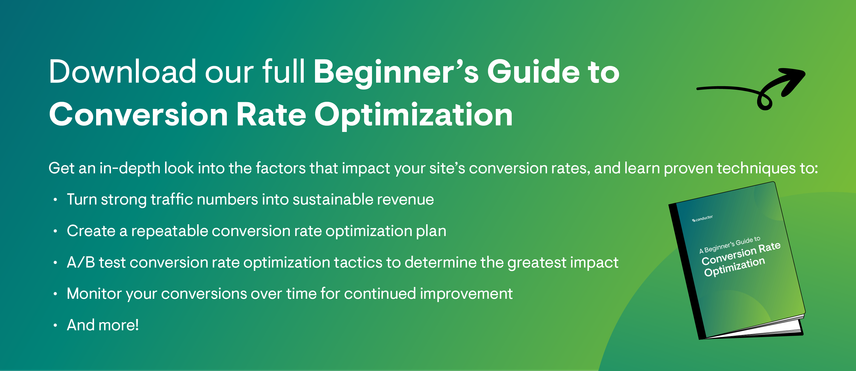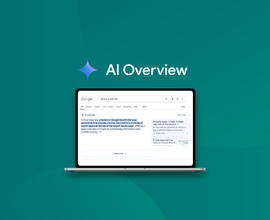A Beginner’s Guide to Conversion Rate Optimization (CRO)
Conversion rate optimization (CRO) is the process of increasing the number of leads that you’re able to drive through your website.
Driving traffic is important, but that traffic isn’t good for much if your visitors don’t take action on your site to become leads or customers.
So, how do you turn more visitors into leads? That's exactly what this guide is all about. We'll explore the fundamentals of conversionConversion
Conversions are processes in online marketing that lead to a defined conclusion.
Learn more rate optimization, benchmarks to target, best practices to improve lead generation, and much more.
What is conversion rate optimization?
Conversion rate optimization is the process of increasing the percentage of visitors who take action on your website to become qualified leads.
What is a conversion rate?
A conversion rate refers to the percentage of website visitors that become leads. For example, if 2 out of every 100 visitors on your website converts, your website’s conversion rate is 2%.
In short, conversions are how you turn visitors into revenue. Visitors can convert by taking an action on your website that displays a potential interest in purchasing, demoing, or taking the next step in a sales process. Those actions can be anything from registering for an event to downloading a piece of content or ultimately making a purchase.
Multiple factors impact conversion rates, with slow load times, inconveniently placed CTA buttons, and subpar content all contributing to poor conversion rates.
Why is conversion rate optimization important?
Conversion rate optimization is important because conversions are revenue drivers and are ultimately what you’re after when it comes to your website. If your website’s content and technical experiences aren’t optimized, they won’t resonate with your audience, won’t convert, and you’ll be leaving money on the table.
Even page loading times can have a negative effect on your revenue. For example, according to an Amazon study, every 100ms in added page load time costs 1% in revenue. While the study is old, it’s one of the first studies that shows the tangible impact of page load times on conversions.
Another study by Google found that increased page load times caused bounce rates among visitors to increase by 123%. As a result, conversion rates among these sites fell dramatically, some by as much as 95%. And that’s just the result of slow page speeds. But conversion rates aren’t just impacted by slow site speeds. Subpar content, poor SEO practices, and technical issues will negatively impact conversions. Issues like poorly optimized CTAs, conversion flows, and mobile-friendly site structure will also impact a conversion rate.
Example
For example, say a critical product page on your site has a 2% conversion rate and drives 1,000 visitors each month. You create a plan to optimize search traffic by 20%, which will increase traffic to 1,200 visitors per month, which, in turn, will drive 24 vs 20 conversions with less traffic.
Now imagine you’re also able to improve your conversion rate from 2% to 2.5% in addition to the 20% traffic growth. That will lead to 1,200 visitors and 30 conversions. That’s a lot of impact from just a .5% bump in conversion rates.

Conversion rate optimization benchmarks
What’s a good conversion rate anyway? That depends on your specific business and your industry.
For example, an eCommerce site will have different conversion benchmarks than a travel website, and while generally, a strong conversion rate is anywhere from 2 to 5% , a strong rate for an eCommerce site may be closer to 2-3%.
Conversion rates also will vary depending on the traffic source. For example, say you’ve created a targeted lead gen campaign through a partner site that sends visitors to a particular piece of content. Those visitors will likely convert better than casual visitors who found your site through other means because those visitors are in a different stage of the customer journey.
Ultimately, you’ll need to decide on a target conversion rate that makes sense for your particular business and industry.

CRO best practices
Optimizing conversion rates and keeping that number strong starts with creating a repeatable process to identify opportunities to improve your website. Below, we’ve laid out a process that has worked for us when it comes to conversion rate optimization.

- Discovery and goal setting: You need to tailor your conversion goals to your specific business and industry. To continue the eCommerce example, setting a conversion rate goal of 8% is likely unrealistic outside of Black Friday campaigns. It’d be great to have that kind of conversion, but you’re unlikely to attain it consistently, which will skew your view of your performance and future goal setting. Do some research into your website’s performance and your industry conversion rate benchmarks and set strategic goals based on those insights. But keep in mind that industry benchmarks can be misleading, so it’s important to benchmark against yourself as well to uncover incremental improvements.
- Research and analysis: Once your goals are set, you’ll need to dive deeper into your website’s performance to identify opportunities to improve. At this point in the process, you’re looking for pages that can or should be converting at a higher rate than they are. If pages aren’t living up to your expectations regarding conversions, those are the ones you should look to improve.
- Forming a hypothesis: Now, you’ll need to decide how to attack the areas of improvement you uncovered. Form a hypothesis on what actions will improve your conversions based on the issues or possible improvements you’ve discovered, whether that’s improving your page loading speed, optimizing your content, adding or moving CTAs, or a combination of updates.
- Experimentation and testing: Next, you’ll need to test your hypotheses to see which ones will have the greatest impact. It’s important at this step to A/B test multiple hypotheses to see which efforts have the most impact and which are worth investing in long-term. For example, if you need to improve your content to drive more intent-driven traffic, maybe you’ll take two different approaches to optimize important pages by updating the CTA placement on one page and optimizing the conversion flow on another. From there, you can determine which one had the most impact on your results. An important consideration for all of your A/B tests is statistical significance. In other words, you need to determine whether the differences you observe between options A and B are likely to be real and not just due to random chance. A common threshold for statistical significance is 95%, meaning you’re 95% confident that the difference is real. If your tests reach this threshold, you can be fairly confident that implementing the winning option will actually improve conversions. If it doesn’t, the differences may just be noise.
Some things to consider when you’re testing theories are sample size and how long you let an experiment run. Testing tools like Optimizely can even handle these calculations for you. - Implementation and iteration: Now, it’s time to consolidate your hypotheses and implement the successful tests. You should have enough information from testing to understand what impact the optimizations will have, so you’ll need to standardize these improvements across your remaining low-converting pages. Then, check back in periodically to ensure they’re having the desired effect on conversions.
- Reporting and documentation: Your initiatives and strategies are only as effective as your reporting and documentation. Take the time to reflect on the initiatives you put into place, what was successful about them, and what wasn’t. This not only helps you create a repeatable process, but it also helps you prove the impact of your work to stakeholders and leadership, making it easier to secure buy-in for future improvements.
- Continued monitoring: Finally, ensure your strategies have their intended long-term impact by monitoring your site’s performance and technical health. Website changes and issues arise constantly and can seriously harm your ability to drive traffic and conversions if you don’t address them. For example, if a product page on an eCommerce site suddenly breaks, you can’t risk leaving it unresolved, or users won’t be able to access a key conversion point. Continued website monitoring is the key to identifying issues before they impact key metrics.
Conversion rate optimization in review
While these fundamentals of conversion rate optimization provide a strong foundation, successful CRO requires ongoing attention, testing, and refinement. Every website and audience is unique, which means the strategies that work best for your business may differ from standard best practices.








